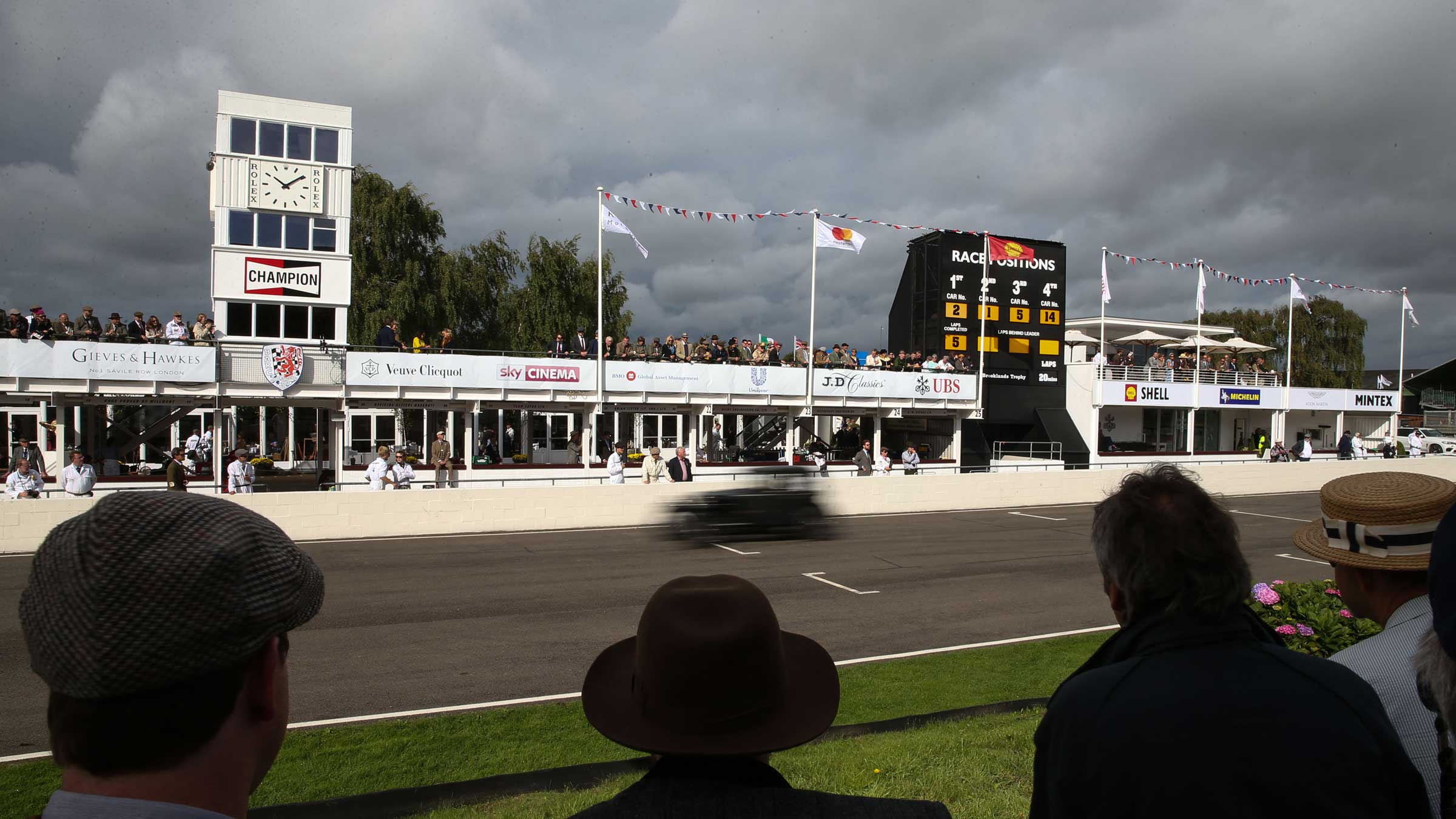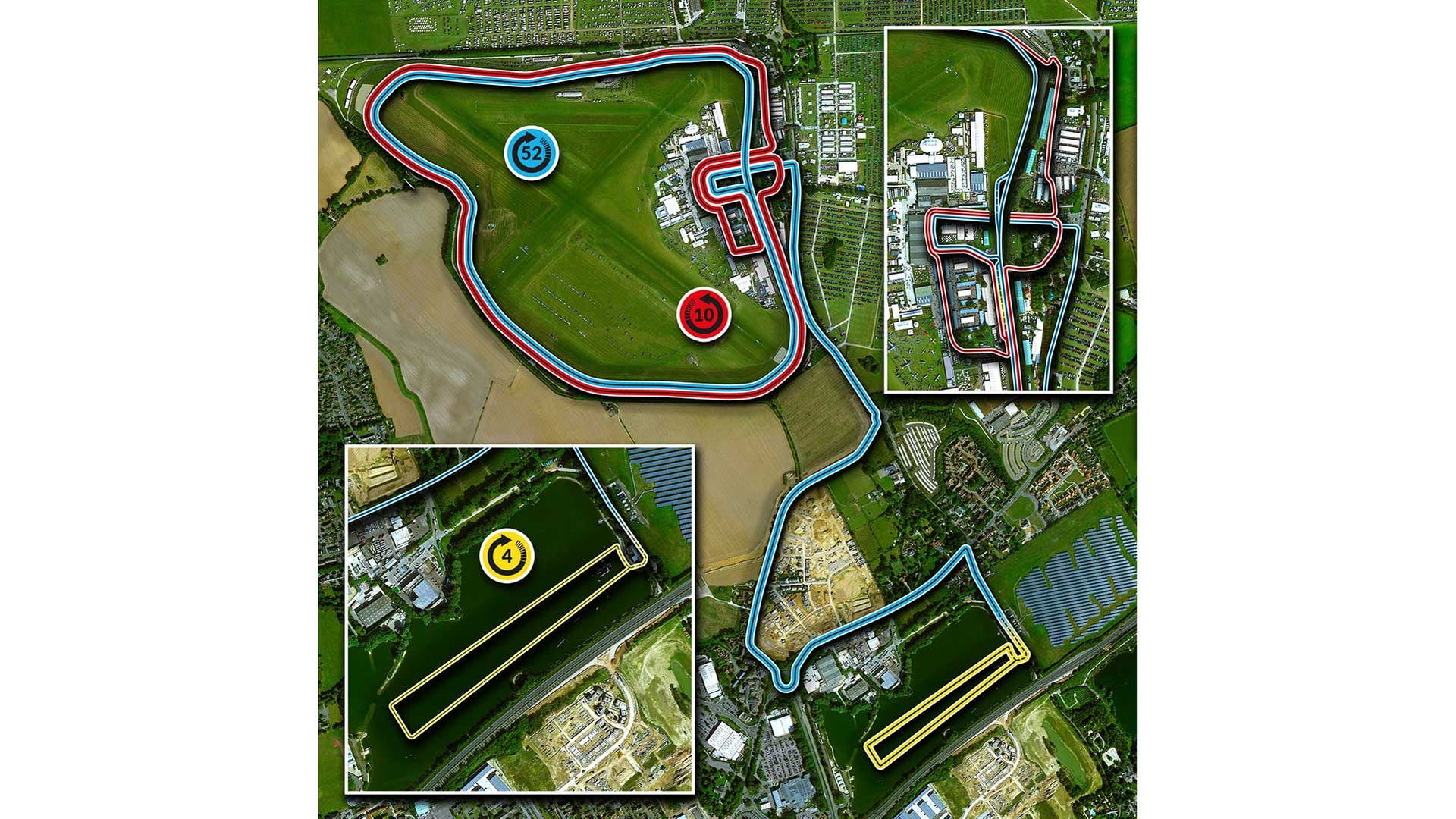This Race Director Is Bringing The World’s Longest Single-Day Triathlon to a Race Track

The race will take place at the Goodwood Motor Racing Circuit, pictured here. (Photo: Andrew Matthews/PA Images via Getty Images)
In a time when many local race organizations are trying to salvage what they can of a race season during a global pandemic, TriBourne Multisport Events is going big–really big. The U.K.-based race organization plans to launch the inaugural 255 Triathlon on Aug. 8, 2021. At 255 kilometers, or just over 158 miles, the event bills itself as “the world’s longest single-day triathlon” and incorporates several novel factors, including a traffic-free, self-contained course on the Goodwood Motor Racing Circuit near Chichester, West Sussex and pit lanes for individual athlete aid stations.
The event was born of COVID-19 necessity, addressing both a desire for athletes to return to racing in a big way while still providing a safe experience. We sat down with race director Matthew Dowle to learn more about 255 Triathlon, the logistics of a self-contained race, and how COVID will impact the race-day experience for all.

Triathlete: When and how did the idea of 255 Triathlon come about?
Matthew Dowle: The past year has given us a unique opportunity, both as athletes and event organizers, to take a step back and reflect on the future of our sport. The initial idea for the 255 Triathlon came from my own perspective as a triathlete. Having completed over 20 Iron-distance races, I’m always looking for new challenges. I like the idea of pushing myself beyond the traditional 140.6-mile distance. However, multi-day stage races don’t appeal to me. Last summer, myself and Dale Anderton, who is also an experienced triathlete and TriBourne Multisport Events co-founder, began to talk about the idea of creating an event which would challenge endurance triathletes to a new level, whilst remaining realistically achievable as a single-day.
We soon settled on the perfect distance: a 5-kilometer swim, 200-kilometer bike, and 50-kilometer run. With an 18-hour time limit, this 255-kilometer format feels to us like a natural evolution and modernization of endurance triathlon events. The long-term vision is to expand into a series of 255 Triathlon events around the world, culminating in a 255 World Championship each year.
Why do you think the idea of going even longer appeals to so many endurance athletes?
I think endurance athletes have an intrinsic desire to push themselves further than that which is considered “normal.” It’s estimated that over a half-million people have now completed an Iron-distance triathlon, which is undoubtably a huge achievement. It is only natural that many of those athletes will want to push themselves even further. For those who have completed an Iron-distance race, simply completing the distance is no longer the challenge. Some seek out the fast, flat courses to challenge their personal best times, while many seek out the toughest possible courses as a way to further challenge themselves. We wanted to provide a new opportunity for endurance triathletes to challenge themselves even further.
It seems that in addition to the physical challenge of covering the distance, there’s also a bit of mental challenge as well due to the repetitive nature of the course–4 laps on the swim, 52 laps of a motor racing loop on the bike, and 10 laps on the run. What factors went into designing this course?
The main reason for designing this multi-lap format was to create an amazing atmosphere and an unparalleled level of engagement between spectators and competitors.
As an athlete, the multi-lap format will certainly add a mental challenge, and we understand that the format will appeal to some people more than others. However, it will also provide an unrivaled level of engagement with supporters, friends, and family. Anyone who has experienced racing endurance events will know the mental boost you get from occasionally seeing your supporters somewhere out on the course, but with this format athletes will get the benefit of that mental lift as they pass the pit lane on every lap.
This course design has also allowed us to create a totally new and innovative relay event. Unlike a traditional triathlon relay, teams of either two, three, or four competitors are able to exchange on any lap during the event to complete the 255-kilometer race in their own customized relay format. This has created a very accessible and flexible relay event, allowing individuals of differing abilities, including long- and short-course athletes, to come together to form teams. This multi-lap relay format will create an amazing atmosphere of team camaraderie throughout a full day of racing.
Why go the self-contained route, instead of covering roads and trails?
Logistically, this format also solves many problems, both from the perspective of an athlete and for us as event organizers. For the athletes, having access to your own box in the pit lane means you can access your own nutrition and special needs throughout the whole event as well as access to a bike mechanic on every lap. There will also be live results on a big screen, giving athletes constant information about their position and progress during the event.
One of the biggest challenges facing race organizers is dealing with the problems of racing on public roads. Having roads closed is becoming more challenging and more expensive. Racing on open roads is also becoming more problematic as traffic levels continue to increase and the highway infrastructure evolves. A traffic-free, multi-lap course does present a few new problems, such as a limited capacity of the course, it does also solve many other problems.
For us, it’s all about the athlete and spectator experience. Our ethos is always to innovate and challenge the status quo to provide amazing event experiences. We have seen how Super League has reimagined short course racing into an exciting, fast and compact race format, and we believe that 255 Triathlon can do the same for long-course racing.
Has COVID impacted your race planning in any way?
Yes, very much so. We have been in regular communication with the British Triathlon Federation as well as local authorities to ensure we can respond quickly to the ever-changing situation. We have included a massive amount of COVID-19 risk mitigation in our plans and our Event Management Plan contains over 24 pages specifically relating to COVID-19. With the level of planning that we have carried out, we believe we are in the best possible position as event organizers to deliver a COVID-19 secure event and we feel very optimistic that with the measures we have in place the event will take place as planned in August.
What about the larger impact of COVID on the racing experience?
I think everyone will have re-evaluated their goals over the past year and many will be looking for new challenges. I know many athletes are very keen to race as soon as possible (myself included) and I expect many races this year will sell out quickly, especially as the capacity at many events will be reduced. Competitors will probably be more inclined to stay local and I hope many will choose to support smaller local race organizers. Sadly, I expect some local races will disappear, but those that remain will probably become bigger.
I think going forward, many of the costs associated with delivering events will increase. We always do our very best to ensure race entry fees do not increase significantly as a result. In our experience, athletes have been very understanding with regards to the financial implications in terms of refund and deferral options.
We are fortunate that non-drafting triathlon is not considered a mass participation sport, but rather an individual sport following a time-trial format. As such we will probably see the return of triathlons sooner than mass participation events such as marathons.
Many of the changes that event organizers have been forced to implement as a result of COVID-19 have actually led to improvements which will be retained after COVID-19 restrictions have ended. We have streamlined our registration, race briefing and finish area procedures and these are improvements which will make for a better race day experience for participants regardless of future COVID-19 requirements.
We are very optimistic about the future of the sport as a whole. We have a wonderful and strong community of organizers, volunteers and competitors, and by working together we are confident the sport of triathlon will continue to grow in the years ahead.
For more information about 255 Triathlon please visit 255triathlon.com.